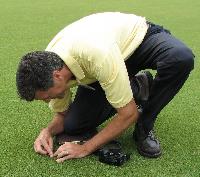|
|
|
|
|
September 07, 2012 -- Volume 50, Number 19
|
|
The Size of Topdressing Sand
| Does it matter?
by James A. Murphy, Ph.D., extension turf specialist, Rutgers University
|
 | |
A significant amount of time and resources is spent on managing the sand particles that remain on the putting surface after topdressing is incorporated.
|
Superintendents welcome techniques that improve the efficiency of operations on the golf course. The incorporation of topdressing sand into a turfgrass canopy is one of those practices where a gain in efficiency is beneficial. Significant time and other resources can be spent on managing the sand particles left on the putting surface after most of the topdressing is incorporated. These remnant particles are typically large (fine gravel, very coarse, or coarse particles, depending on the quality of the sand) and interfere with mowing and potentially play, if not removed. Blowers can be used to remove these particles, but at the cost of more labor and fuel. Daily mowing eventually removes these large particles, but at the cost of increased mower maintenance through more frequent sharpening and replacement of bedknives and reels.
The incorporation of topdressing sand is more difficult on turf maintained at lower mowing heights and with plant growth regulation that increases shoot density, calculated as the number of turfgrass shoots per square inch. Additionally, newer cultivars developed for putting greens have much greater shoot density compared to older cultivars. Topdressing sand increases the firmness of a putting green surface due to the "bridging" of sand particles within the turf canopy and layer of mat or thatch. However, the bridging among sand particles and with plant material also contributes to the difficulty of incorporating sand.
|
All Things Considered - A Green Section Staff Opinion
| My three wishes for better golf.
by Derf Soller, agronomist, Northwest Region. | |
In recent y ears many have written that the game of golf is too difficult, and that this is a primary obstacle against increasing golfer participation. I have the opposite opinion. In fact, I believe learning to play golf is easier than ever due in large part to the many advances in equipment technology and accessibility to so many golf courses today. What I believe is hurting the game the most is that it seems many of us have lost sight of the goal of having fun when we play. Fun is, and should continue to be, the main reason the majority of us visit golf courses in the first place. Looking back to when we first learned to play the game, we were not concerned about perfect ball lies, consistent green speeds, or manicured bunkers. The intrigue and enjoyment of the game stemmed from being on the course and trying our best to get the ball from tee to green and eventually into the hole. Even more fun was to be had when there was friendly competition with other players. ears many have written that the game of golf is too difficult, and that this is a primary obstacle against increasing golfer participation. I have the opposite opinion. In fact, I believe learning to play golf is easier than ever due in large part to the many advances in equipment technology and accessibility to so many golf courses today. What I believe is hurting the game the most is that it seems many of us have lost sight of the goal of having fun when we play. Fun is, and should continue to be, the main reason the majority of us visit golf courses in the first place. Looking back to when we first learned to play the game, we were not concerned about perfect ball lies, consistent green speeds, or manicured bunkers. The intrigue and enjoyment of the game stemmed from being on the course and trying our best to get the ball from tee to green and eventually into the hole. Even more fun was to be had when there was friendly competition with other players.
What if a golf genie were to grant us three wishes to improve the game? What would your wishes be? This is my chance to share mine.
Read the rest of this article
|
Still Stinging
| University of Florida research compares bermudagrass and seashore paspalum cultivars for their abilities to tolerate nematodes.
by Jeff Nus, Ph.D. manager, Green Section Research.
|
 | | University of Florida graduate student Wenjing Pang takes soil samples of bermudagrass cultivars in an effort to compare them for their abilities to tolerate both sting and spiral nematodes without showing visual decline. |
The crucial component of any turf pest control strategy is to use turfgrass cultivars that have the greatest genetic resistance to that pest. After all, if the turf is genetically resistant to certain diseases or insects, there is less dependency on fungicides and insecticides to keep the turf healthy. Can the same strategy be used for nematodes?
That is exactly what University of Florida scientists wanted to know. According to a 2005 field survey of Florida golf courses by Dr. William (Billy) Crow, associate professor of nematology at the University of Florida, 87% of those courses had potentially damaging levels of plant-parasitic nematodes. With the loss of Nemacur (fenamiphos) in 2007, questions regarding nematode resistance in turfgrass cultivars are more important than ever.
With funding from the USGA Turfgrass and Environmental Research Program, Dr. Crow and his colleagues, Dr. Kevin Kenworthy (assistant professor of plant breeding) and graduate student Wenjing Pang, initiated studies to evaluate bermudagrass and seashore paspalum cultivars for their abilities to resist nematode infestations (2, 3, 4, 5). "I am often asked by golf course superintendents if a particular cultivar is resistant or has fewer problems with nematodes than other cultivars," explains Dr. Crow. "I really wanted to have some research results to answer those types of questions.Use of plant resistance and tolerance is the most long-lasting and environmentally friendly method for controlling pests."
Read the rest of this article
|
USGA Green Section Record Survey
| Less than two minutes of your time will help us serve you better
by the Green Section Staff
| |

Our goal is to provide information to you that is pertinent, timely, and in an easy-to-read format. Your participation in this brief survey will help us achieve that goal. Please take a few minutes to complete the following survey and provide your feedback.
Thank you.
Take the survey
|
| Regional Updates | |
The USGA Green Section agronomists see an amazing variety of issues and challenges as they visit golf courses across the country. Be sure to read the highlights of each region since many of the topics covered apply to courses everywhere.
 Mid-Atlantic Region
This update includes:
Insights on fall aeration, inconsistent roughs, and renovation.
View the rest of this update

Southeast Region
This update includes:
Hi-tech tools to evaluate the impact of trees and other structures on turf.
View the rest of this update.  Mid-Continent Region
 North-Central Region This update includes: Relationships and good grass - they have more in common than you might think. View the rest of this update
 Northeast Region Northeast Region
This update includes: Extreme weather conditions can actually help your course in the long run.
View the rest of this update
 Florida Region Florida Region
| This update includes:
Environmental initiatives including BMP's for Florida golf courses and Rounds 4 Research. View the rest of this update.
|
|
Sign Up To Receive The Record
Forward The Record To A Friend
| It's easy to subscribe to the Record and to share it with others
| Each Green Section Record issue includes articles and information that appeal to golfers and those who work in the game. It is always free of advertising and free of charge. Please help us distribute this publication as widely as possible. The best way to do this is sign up if you are not already a subscriber, and to forward this publication to your friends.
Thanks for your help! |
| Green Section Record Archive | Looking for a previous issue of the Green Section Record?
|
 | | Looking for something? |
The Green Section Record has been published under various names since 1921 and is composed of an amazing collection of full-text articles and photos. This collection is stored and maintained by the wonderful library staff at Michigan State University in the Turfgrass Information File (TGIF). All past issues of the Record, including this one, can be accessed free-of-charge by following this link.
Search the Green Section Record |
|
|
|
©2012 by United States Golf Association®
Permission to reproduce articles or material in the USGA Green Section Record is granted to
newspapers, periodicals, and educational institutions unless specifically noted otherwise. All materials must be used in their entirety. Credit must be given to the author, the article's title, the USGA Green Section Record, and the issue's date. Copyright protection must be afforded.
No material may be copied or used for any advertising, promotion or commercial purposes.
Green Section Record (ISSN 2156-5813) is published biweekly via electronic mail by the
United States Golf Association®, Golf House, Far Hills, NJ 07931.
USGA Green Section
USGA Green Section
908.234.2300 | |
|
|
|
|
|